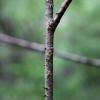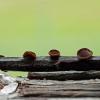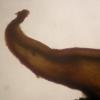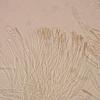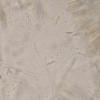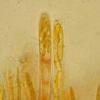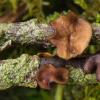
24-11-2025 15:23
Arnold BüschlenHallo, auf einer offenen Kiesfläche am Rande ein

23-11-2025 11:16
Bohan JiaHi, I found small discs growing on dead stem of

21-11-2025 10:56
 Christopher Engelhardt
Christopher Engelhardt
Very small (~0,5 mm) white ascos, found yesterday

21-11-2025 11:52
Jean-Luc RangerBonjour à tous, on voit toujours 2 espèces areni

14-11-2025 16:26
 Marian Jagers
Marian Jagers
Hello everyone, On dead wood of Cytisus scoparius

17-11-2025 21:46
Philippe PELLICIERBonjour,Récolté sur bois pourrissant de feuillu
Encoelia
Elisabeth Stöckli,
29-06-2016 18:06
Trouvé sur branches mortes cortiquées de Salix (Saulaie buissonnante alluviale à 1110m), apothécies 2.5-8mm de diamètre, stipitées, hyménium brun ochracé, surface externe plus foncé, asques 125-150x7.5-10µm, octosporés, IKI+, spores allantoides, hyalines et lisses, 1 à 3 cloisons à maturité, 12-18x2.9-3.8µm, paraphyses filiformes, septées, faiblement élargies au sommet, contenant un pigment brun.
Nous pensons que c'est Encoelia tiliacea. Merci pour votre avis.
Elisabeth
Hans-Otto Baral,
29-06-2016 18:40

Re : Encoelia
Ja, bestimmt ist sie das. Ich denke aber dass Kadri da Interesse hat, ihre zwei Sequenzen stammen nämlich von Tilia, sodass man nicht wissen kann, ob es auf Weide nicht eine andere Art gibt. ich werde sie mal fragen.
Viele Grüße
Zotto
Viele Grüße
Zotto
Gernot Friebes,
20-11-2025 21:56
Ueli Graf,
24-11-2025 22:28

Re : Encoelia
Hallo Elisabeth, wann hast du diesen Fund gemacht?
Sehr gute Fotos.
Gruss Ueli


